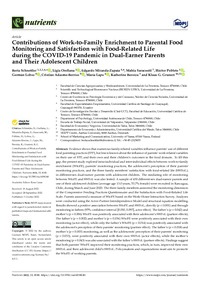Mostrar el registro sencillo de la publicación
Contributions of work-to-family enrichment to parental food monitoring and satisfaction with food-related life during the covid-19 pandemic in dual-earner parents and their adolescent children
| dc.contributor.author | Schnettler, Berta | |
| dc.contributor.author | Orellana, Ligia | |
| dc.contributor.author | Miranda-Zapata, Edgardo | |
| dc.contributor.author | Saracostti, Mahia | |
| dc.contributor.author | Poblete, Héctor | |
| dc.contributor.author | Lobos, Germán | |
| dc.contributor.author | Adasme-Berríos, Cristian | |
| dc.contributor.author | Lapo, María del Carmen | |
| dc.contributor.author | Beroíza, Katherine | |
| dc.contributor.author | Grunert, Klaus G. | |
| dc.date.accessioned | 2022-12-26T13:16:48Z | |
| dc.date.available | 2022-12-26T13:16:48Z | |
| dc.date.issued | 2022 | |
| dc.identifier.uri | http://repositorio.ucm.cl/handle/ucm/4271 | |
| dc.description.abstract | Evidence shows that numerous family-related variables influence parents’ use of different food parenting practices (FPP), but less is known about the influence of parents’ work-related variables on their use of FPP, and their own and their children’s outcomes in the food domain. To fill this gap, the present study explored intra-individual and inter-individual effects between work-to-family enrichment (WtoFE), parents’ monitoring practices, the adolescent’s perception of their parents’ monitoring practices, and the three family members’ satisfaction with food-related life (SWFoL), in different-sex dual-earner parents with adolescent children. The mediating role of monitoring between WtoFE and SWFoL was also tested. A sample of 430 different-sex dual-earner parents and one of their adolescent children (average age 13.0 years, 53.7% female) were recruited in Rancagua, Chile, during March and June 2020. The three family members answered the monitoring dimension of the Compressive Feeding Practices Questionnaire and the Satisfaction with Food-Related Life Scale. Parents answered a measure of WtoFE based on the Work–Home Interaction Survey. Analyses were conducted using the Actor–Partner Interdependence Model and structural equation modelling. Results showed a positive association between WtoFE and SWFoL, directly (p < 0.001) and through monitoring in fathers (95% confidence interval [0.010, 0.097], actor effect). The father’s (p = 0.042) and mother’s (p = 0.006) WtoFE was positively associated with their adolescent’s SWFoL (partner effects). The father’s (p = 0.002) and mother’s (p = 0.036) WtoFE were positively associated with their own monitoring (actor effect), while only the father’s WtoFE (p = 0.014) was positively associated with the adolescent’s perception of their parents’ monitoring (partner effect). The father’s (p = 0.018) and mother’s (p = 0.003) monitoring, as well as the adolescents’ perception of their parents’ monitoring (p = 0.033), were positively associated with their own SWFoL (actor effects), while the mother’s monitoring (p = 0.043) was also associated with the father’s SWFoL (partner effects). Findings suggest that both parents’ WtoFE improved their monitoring practices, which, in turn, improved their own SWFoL and their adolescent child’s SWFoL. Policymakers and organizations must aim to promote the WtoFE of working parents. | es_CL |
| dc.language.iso | en | es_CL |
| dc.rights | Atribución-NoComercial-SinDerivadas 3.0 Chile | * |
| dc.rights | Atribución-NoComercial-SinDerivadas 3.0 Chile | * |
| dc.rights.uri | http://creativecommons.org/licenses/by-nc-nd/3.0/cl/ | * |
| dc.source | Nutrients, 14(19), 4140 | es_CL |
| dc.title | Contributions of work-to-family enrichment to parental food monitoring and satisfaction with food-related life during the covid-19 pandemic in dual-earner parents and their adolescent children | es_CL |
| dc.type | Article | es_CL |
| dc.ucm.facultad | Facultad de Ciencias Sociales y Económicas | es_CL |
| dc.ucm.indexacion | Scopus | es_CL |
| dc.ucm.indexacion | Isi | es_CL |
| dc.ucm.uri | mdpi.com/2072-6643/14/19/4140 | es_CL |
| dc.ucm.doi | doi.org/10.3390/nu14194140 | es_CL |



